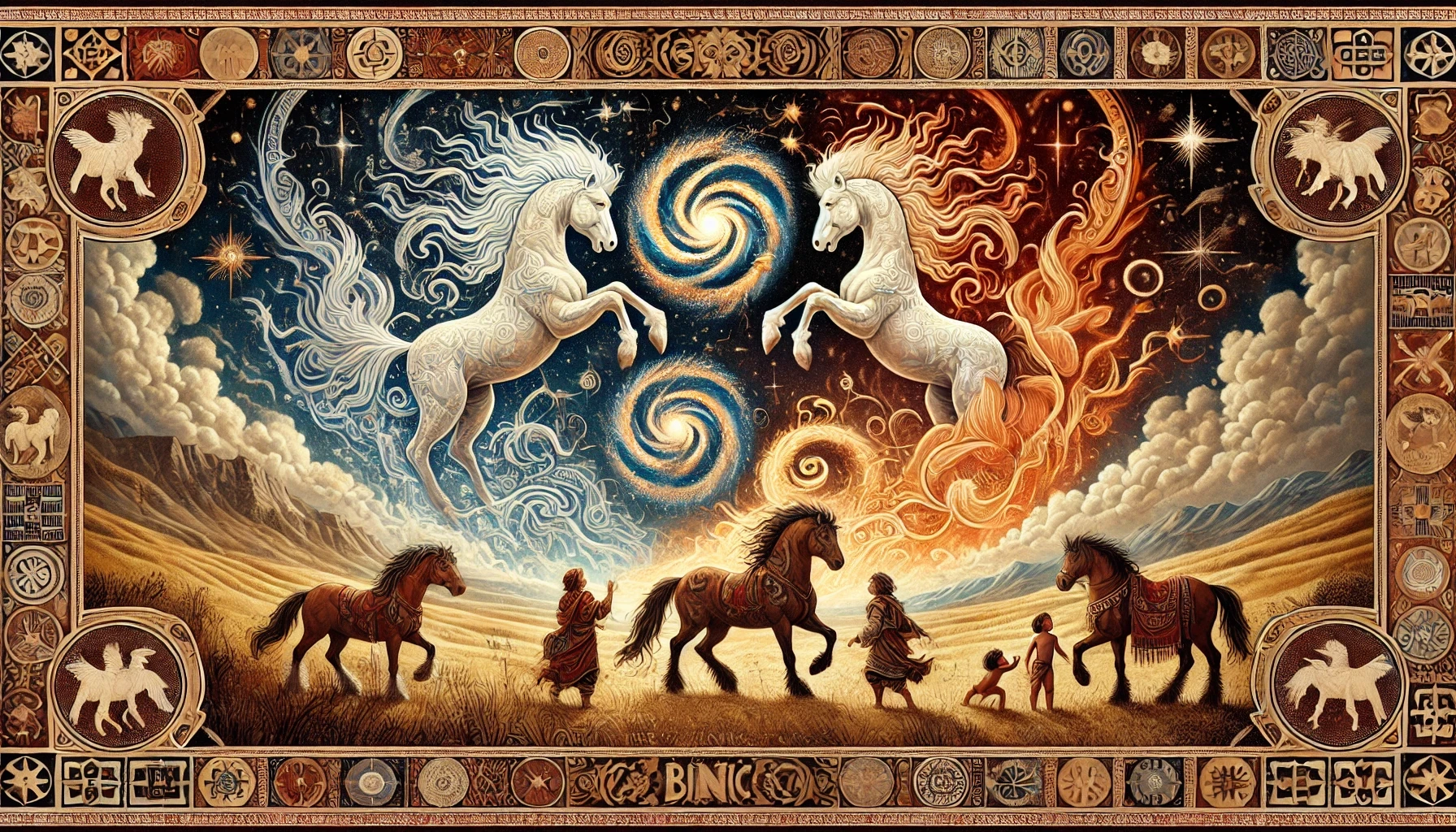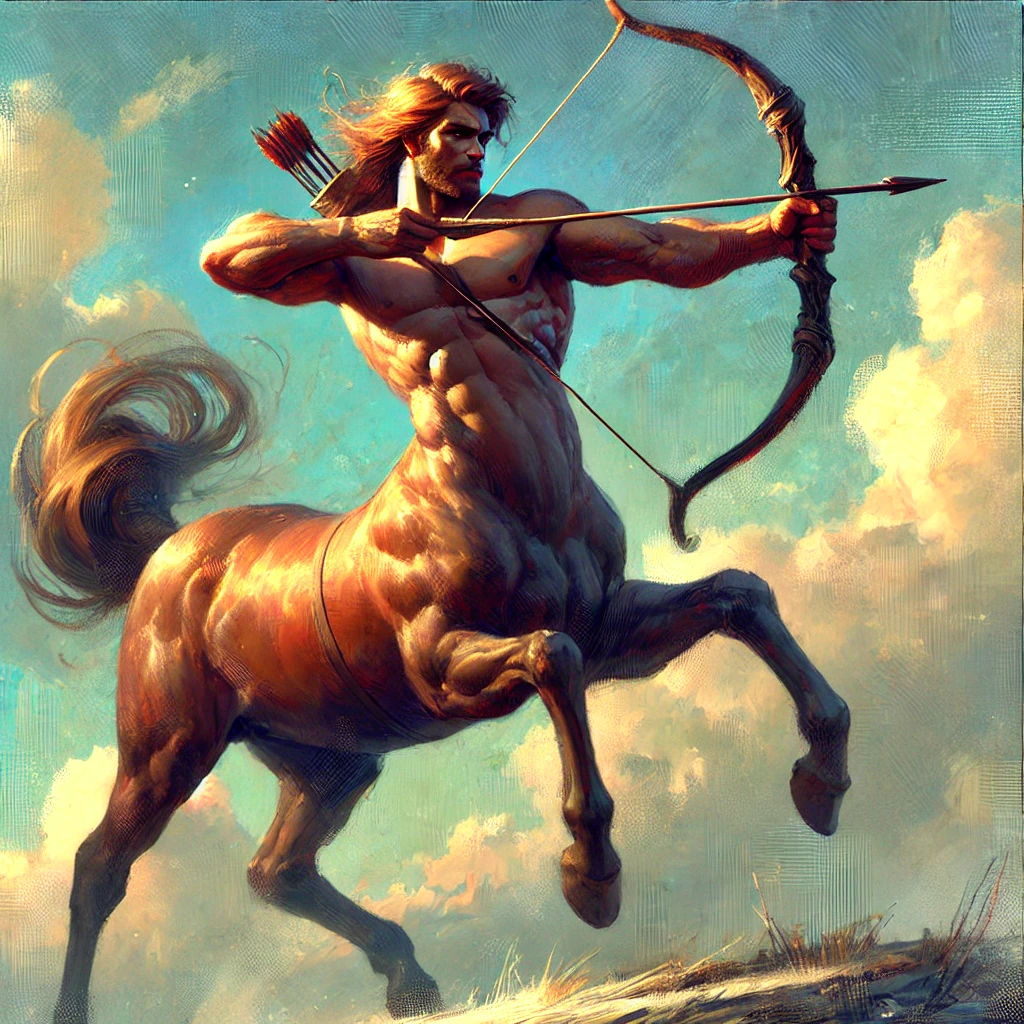Kheiron and the Agyir
The Agyir people believe that they were created by Kheiron, the Centaur god, as beings that embodied the perfect union of strength and intellect, represented by the horse and human forms combined. These original beings, a fusion of both, roamed the vast plains of Eouma, living in harmony and reflecting divine balance.
However, as the myth goes, Kheiron noticed that this perfection led to stagnation. Without challenges or reliance on another, the beings lacked humility and the drive to grow. To teach them the value of partnership and interdependence, Kheiron chose to separate them into two distinct forms: human and horse.
Before he separated them, Kheiron promised that their connection would never truly be severed. Through dedication and trust, they would be able to reunite, forging bonds that were deeper than before. These reunions would not only restore their unity but teach them patience, understanding, and balance in their dual natures.
The Gift of Horses
After the separation, Kheiron entrusted the plains of Eouma to the wild horses. These creatures were not ordinary animals but spiritual descendants of Kheiron himself, imbued with intelligence, loyalty, and longevity. The Agyir were tasked with finding their “other half” among these divine creatures, not to tame them but to bond with them as equals. This sacred bond would represent a fulfillment of Kheiron's promise: a reunification of two halves, creating a partnership built on mutual respect and trust. The At Binici ceremony was established as a rite to honor this promise and symbolize the Agyir's commitment to the divine balance.Historical Basis
While the myth of Kheiron’s creation of the Agyir and their sacred bond with horses is steeped in divine narrative, elements of it may reflect historical truths. Ancient records and artifacts suggest a time when the Agyir began domesticating the unique Eouman horses, whose intelligence and longevity set them apart. This monumental shift in their culture likely inspired the story of a divine connection, with Kheiron's intervention representing the transformative partnership between human and horse. Combined with celestial phenomena, such as bright stars or unusual migrations, the myth blends historical events with divine influence, solidifying its place in Agyir tradition.
In Art
The myth of Kheiron and the At Binici tradition has profoundly influenced the artistic expression of the Agyir people and beyond, inspiring works that span visual, musical, and sculptural art forms. These creations celebrate the sacred bond between human and horse while preserving the legend across generations.
Visual Art
- Paintings and Tapestries: Large, intricate tapestries often depict Kheiron’s act of separation, showing him in radiant form dividing the unified beings into human and horse under a celestial sky. These pieces are richly detailed, with vibrant colors representing divine energy and balance.
- Some works portray pivotal moments of the At Binici ceremony, such as the bonding of child and horse, symbolizing the continuation of Kheiron’s promise.
- Murals in communal halls and sacred sites illustrate the golden herds of legend, running free under starry skies, symbolizing unity and strength.
- Statues and Carvings: Shrines dedicated to Kheiron often feature statues of the god as a towering centaur holding a star in one hand and reins in the other, signifying his role as guide and protector.
- Smaller carvings of horses, often placed in households, are believed to bring blessings of harmony and endurance, embodying the spirit of the divine herd.
Music and Song
- Ceremonial Hymns: Songs sung during the At Binici ceremony invoke Kheiron’s name, recounting the myth and the sacred bond it represents. These hymns are often accompanied by rhythmic drumming and melodic instruments designed to mimic the sound of galloping hooves.
- Epic Ballads: Traveling bards sing of the legendary golden herd or heroic tales of mythical horse-rider pairs, celebrating the enduring connection between Agyir culture and their divine origins.
Literature and Oral Tradition
- Story Scrolls: Written accounts, illuminated with drawings, retell the myth in narrative form, often gifted to children as they prepare for the At Binici ceremony.
- Oral Histories: Storytellers bring the legend to life during festivals, weaving elements of drama and moral lessons into their performances.
Architectural Influence
- The legend also inspires architectural designs, such as the circular layout of ceremonial grounds mirroring unity and balance.
- Monuments often feature horse motifs, and pathways leading to sacred sites are sometimes flanked by sculptures representing Kheiron’s herd.

Date of First Recording
Approximately 200 HE
Date of Setting
Estimated to be around 2000 BHE
Telling / Prose
Related Ethnicities
Related Species
Related Locations
Related People
Related Organizations





Comments